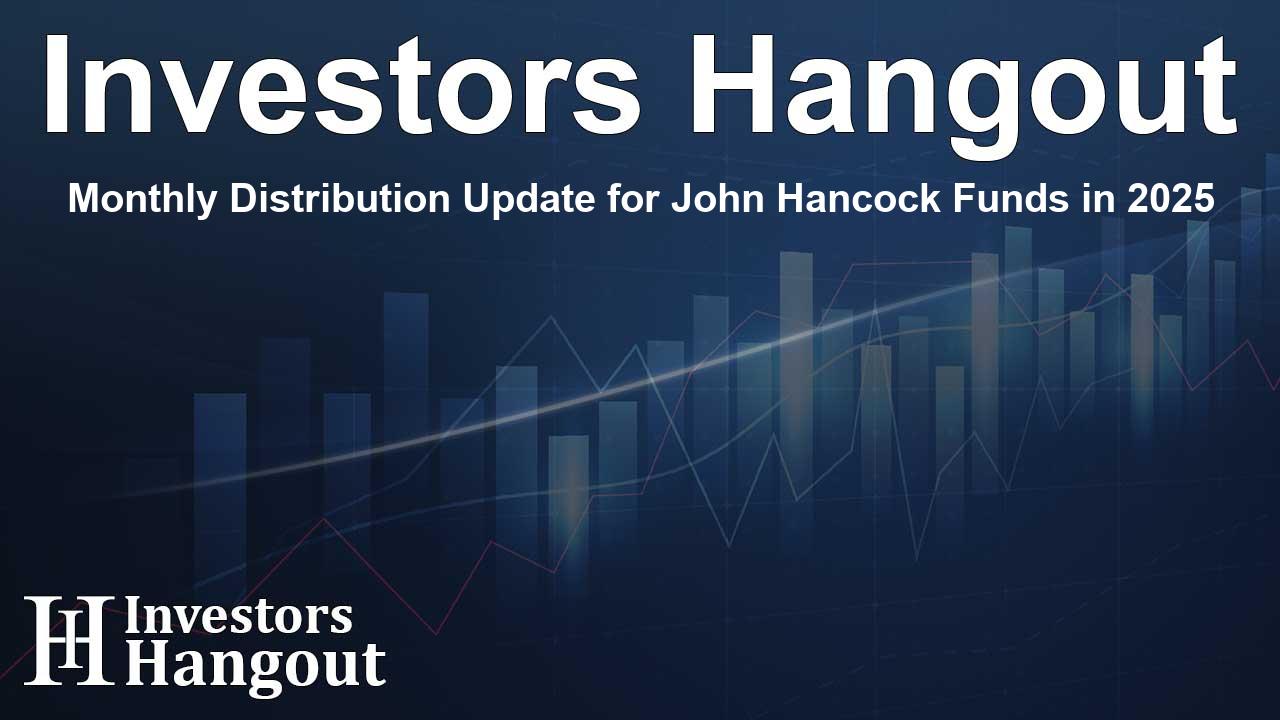Monthly Distribution Update for John Hancock Funds in 2025

Monthly Distribution Announcement from John Hancock Funds
John Hancock closed-end funds have announced their latest monthly distributions. This news is particularly significant for investors keeping an eye on their returns and performance metrics. The funds have declared their distributions, detailing specific amounts that will benefit shareholders.
Distribution Details Overview
The distribution declaration was made recently, with the anticipated ex-date and record date closely following. Key dates to note include the declaration date, the ex-date set for later in February, the record date, and the payment date which is also at the end of February. This well-structured timeline allows investors to plan their financial strategies effectively.
Distribution Breakdown by Fund
Several John Hancock funds have specific distribution amounts that are noteworthy. For instance, the Preferred Income Fund I has a distribution of $0.1235 per share, while the Preferred Income Fund II matches that amount. Furthermore, the Preferred Income Fund III offers a slightly lower distribution of $0.1100. Each fund’s market price is also essential for investors to evaluate performance.
The Premium Dividend Fund sees a distribution of $0.0825, which is beneficial for shareholders as it supports ongoing income strategies. In contrast, the Tax-Advantaged Dividend Income Fund presents a higher distribution of $0.1380, indicating its strong financial performance and potential for growth.
Understanding Distribution Sources
It's vital for investors to grasp that distributions may not solely be from net investment income. They can also arise from realized capital gains and, if necessary, funds may return capital to shareholders. Understanding the components of these distributions is crucial for tax implications and overall investment strategy.
Implications of the Distribution Plans
John Hancock’s approach to managing distributions is methodical, with both the PDT and HTD Plans ensuring investors receive their due monthly distributions. These plans aim to optimize returns, maintain fiscal responsibility, and avoid unnecessary tax burdens on shareholders. Investors should be aware of the implications and the areas that may affect returns.
Investor Guidance and Awareness
Investors need to be educated about the possibility of distribution components that may include a return of capital. This aspect can sometimes lead to confusion regarding income sources. Transparency about the nature of these distributions can guide shareholders during tax season and influence future investment decisions.
John Hancock emphasizes the importance of keeping investors informed. Notifications regarding distribution components are sent out to ensure clarity. Understanding these communications allows investors to prepare for their tax obligations effectively.
About John Hancock Investment Management
John Hancock Investment Management operates under the umbrella of Manulife Investment Management. The firm is known for its unique multimanager strategy, combining its robust in-house capabilities with specialized asset management teams. This innovative approach results in a diverse portfolio that offers investors time-tested choices backed by rigorous investment oversight.
Manulife’s Global Presence and Commitment
As the global entity for Manulife Financial Corporation's wealth and asset management, John Hancock stands out in the industry. The firm leverages over a century of expertise in financial stewardship to serve a wide range of clients. Their commitment to responsible investing aligns with modern financial principles, ensuring clients’ interests are prioritized across all offerings.
Frequently Asked Questions
What are the main funds mentioned in the distribution announcement?
The main funds mentioned include Preferred Income Fund I, Preferred Income Fund II, Preferred Income Fund III, Premium Dividend Fund, and Tax-Advantaged Dividend Income Fund.
How does the distribution declaration impact investors?
The distribution impacts investors by providing expected income through monthly payments, which can be a crucial part of their investment strategy.
What should investors understand about capital returns?
Investors need to understand that returns may include capital, which can affect their perceived income from the funds, particularly regarding tax reporting.
Why is it important to pay attention to distribution sources?
Knowing the sources of distribution helps investors understand the sustainability of their income and prepares them for tax implications. This knowledge is essential for effective investment planning.
How can investors stay informed about distribution changes?
Investors can stay informed through communications from John Hancock and regularly check updates regarding distributions on their platforms.
About The Author
Contact Thomas Cooper privately here. Or send an email with ATTN: Thomas Cooper as the subject to contact@investorshangout.com.
About Investors Hangout
Investors Hangout is a leading online stock forum for financial discussion and learning, offering a wide range of free tools and resources. It draws in traders of all levels, who exchange market knowledge, investigate trading tactics, and keep an eye on industry developments in real time. Featuring financial articles, stock message boards, quotes, charts, company profiles, and live news updates. Through cooperative learning and a wealth of informational resources, it helps users from novices creating their first portfolios to experts honing their techniques. Join Investors Hangout today: https://investorshangout.com/
The content of this article is based on factual, publicly available information and does not represent legal, financial, or investment advice. Investors Hangout does not offer financial advice, and the author is not a licensed financial advisor. Consult a qualified advisor before making any financial or investment decisions based on this article. This article should not be considered advice to purchase, sell, or hold any securities or other investments. If any of the material provided here is inaccurate, please contact us for corrections.
